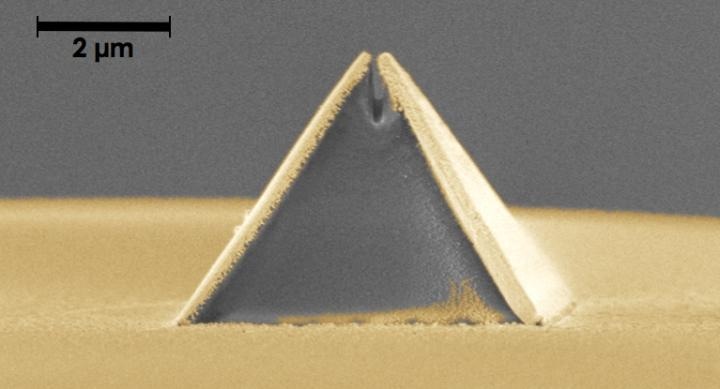 Berkeley Lab
Berkeley Lab
Science and art have come together to create a new fabrication method to print a nanoscale imaging probe onto the tip of a glass fibre as thin as a human hair.
The process combines speed with incredible precision, and could help accelerate the production of the promising new device from several per month, to several per day. The high-throughput technique – called fibre nanoimprinting – could pave the way for the widespread adoption of this and other nano-optical structures that manipulate light in ways unachievable in conventional optics.
Nano-optics have a wealth of potential uses; imaging, sensing and spectroscopy, for example, all of which could help scientists design better drugs, make faster semiconductors and improve solar cells. However, a massive obstacle to the technology’s commercial application is it’s time consuming production process.
Fibre nanoimprinting could speed up the process, and has been developed by scientists at the Molecular Foundry, located at the US Department of Energy’s Lawrence Berkeley National Laboratory, in partnership with aBeam Technologies.
The work – published in Scientific Reports – builds on the Campanile probe developed by Molecular Foundry scientists four years earlier. The probe resembles the top of the Campanile clock tower at the University of California Berkeley’s campus, with its tapered, four-sided shape. The probe is mounted at the end of an optical fibre and can focus an intense beam of light onto a much smaller spot than is possible with current optics.
Conventional spectroscopy is able to map the average chemical composition of a material. The Campanile probe enables spectroscopic imaging at a resolution 100 times greater, meaning it can image the molecule-by-molecule configuration of nanoparticles and other materials. It could help scientists examine a nanowire for minute defects, leading to new ways to improve nanowires for use in more efficient solar cells.
Fabricating the Campanile probe has been described as ‘part science and part art’. This and other nano-optical devices require milling a 3D shape with sub-100nm scale features on the tip of a wispy fibre.
“When we first made a Campanile probe, we sculpted it with an ion beam like Michelangelo. It took about a month,” said Stefano Cabrini, director of the Nanofabrication Facility at the Molecular Foundry. “That pace is ok for research applications, but the lack of a mass-fabrication method had inhibited the wider use of nano-optical devices.”
But fibre nano-imprinting could change that. The first step is the most time consuming and sees scientists creating a mould with the precise dimensions of the nano-optical device they want to print. For the Capanile probe this means a mould of the probe’s nanoscale features, including the four sides and a light emitting 70nm wide gap at the pyramid’s top.
“This mould can take a few weeks to make, but we only need one, and then we can start printing," explains Keiko Munechika of aBeam Technologies.
Once created, the mould is filled with a special resin and positioned upon an optical fibre. Infrared light is sent through this fibre, which allows scientists to measure the exact alignment of the mould in relation to the fibre. If everything is correct, UV light is sent through the fibre to harden the resin. A final metallisation step coats the sides of the probe with gold layers. The result is a quickly printed - not meticulously sculpted - Campanile probe.
"We can do this over and over and make a probe every few minutes," says Munechika.
There are several advantages to the faster production pace: the probes are fragile, and now it's possible to give researchers a batch in case one breaks. It is also easier to optimise nano-optical devices if scientists are able to provide feedback on a device's performance, and an improved batch is quickly developed for further testing.
The fabrication technique can also be applied to any nano-optical device, and has so far been used to create Fresnel lenses and beam splitters in addition to the Campanile probe.
"Instead of sculpting a one-of-a-kind device like Michelangelo, we now take the original masterpiece, make an imprint of it, and create many replicas in quick succession," says Cabrini.
Source: EuerekaAlert
Disclaimer: The views expressed here are those of the author expressed in their private capacity and do not necessarily represent the views of AZoM.com Limited T/A AZoNetwork the owner and operator of this website. This disclaimer forms part of the Terms and conditions of use of this website.